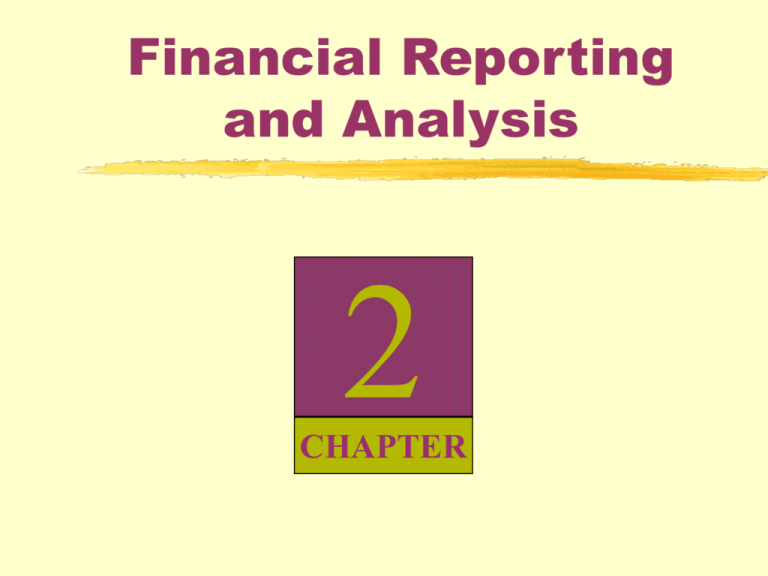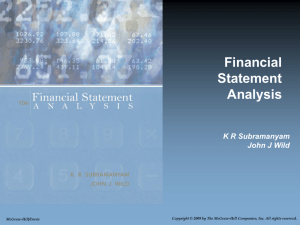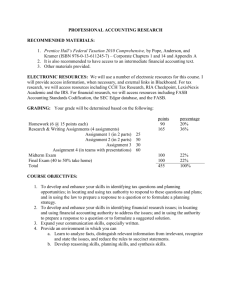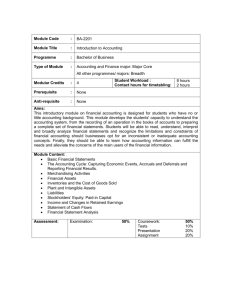Financial Reporting and Analysis
advertisement

Financial Reporting and Analysis 2 CHAPTER Financial Reporting Environment Regulators Alternative Information Sources Industry Practices Economy and Industry Information FASB GAAP Managers Voluntary Disclosure AICPA Analysts Statutory Financial Reports (Financial Statements) SEC Corporate Governance Litigation Auditors Enforcement and Monitoring Mechanisms Investors and Creditors Other Users Users Form 10-K (Annual Report) 10-Q (Quarterly Report) 20-F (Registration Statement/ Annual Report [Foreign]) 8-K (Current Report) Statutory Financial Reports 14-A (Proxy Statement/ Prospectus) Other SEC Filings Earnings Announcements Key summary measures (pre-audit) Often one to six week lag Informative to market Lacks supporting financial details Environmental Factors GAAP Generally Accepted Accounting Principles Level I (Most authoritative) Level II Level III Level IV (Least authoritative) FASB Standards and Interpretations FASB Technical Bulletins APB Opinions AICPA Industry Audit & Accounting Guidelines FASB Emerging Issues Task Force FASB Implementation Guides AICPA(CAP) Accounting Research Bulletins AICPA Interpretations AICPA Statement of Position AICPA Practice Bulletins Recognized and Widely Used Industry Practices Environmental Factors Unions Securities and Exchange Commission AICPA Investors Lenders Politicians Accountants Others Provide input to Financial Accounting Standards Board Help set Generally Accepted Accounting Principles Environmental Factors Securities and Exchange Commission (SEC) Independent, quasi-judicial government agency Administer securities regulations & disclosures Can modify & set GAAP, if necessary Rarely directly challenges FASB Major player in global accounting Environmental Factors International Accounting Standards (IAS) Set by International Accounting Standards Board Not currently accepted in U.S. SEC under pressure to accept IAS Environmental Factors Managers of Companies Main for fair &Accounting accurate reports Setresponsibility by International Applies accounting to reflect business Standards Board activities Not currently accepted in in U.S. Managerial discretion is necessary accounting SEC underonpressure to accept Major lobbyist GAAP IAS Environmental Factors Auditing SEC requires Audit Report Accounting Set by International Audit opinion can be: Standards Board - clean (fairly presented) Not -currently accepted qualified (except for) in U.S. Auditors - disclaimer (no opinion) SEC under pressure to accept Check Auditor quality & independence IAS Environmental Factors Corporate Governance Board oversightAccounting Set of bydirectors International Audit committeeBoard of the board Standards - oversee accounting process Not currently accepted in U.S. -oversee internal control - oversea internal/external audit SEC under pressure to accept Internal Auditor IAS Environmental Factors Internal Users External Users Managers Officers Internal Auditors Sales Managers Budget Officers Controller Lenders Shareholders Governments Labor Unions External Auditors Customers Environmental Factors Equity Investors Active & Speculative Investors rely on financial reports Creditors Solvency & Liquidity analysis relies on financial reports Environmental Factors Economic, Industry & Company News Impacts current & future financial condition and performance Voluntary Disclosure Many factors encourage voluntary disclosure by managers Information Intermediaries Industry devoted to collecting, processing, interpreting & disseminating company information Includes analysts, advisers, debt raters, buy- and sell-side analysts, and forecasters Major determinant of GAAP Financial Accounting Objectives Stewardship • Safeguard assets • Increase equity value • Protect creditors Accountability & Performance Measurement Historical Emphasis (but still important) Information Perspective • Amount …of • Timing prospective • Uncertainty net cash inflows Predictability & Decision Usefulness Modern Emphasis Financial Accounting Hierarchy of Accounting Qualities Users of accounting information Decision makers and their characteristics Benefits > Costs Constraints Materiality Understandability User-specific qualities Primary qualities Ingredients of primary qualities Decision usefulness Relevance Predictive value Reliability Feedback value Neutrality Representational faithfulness Timeliness Secondary qualities Verifiability Comparability and consistency Financial Accounting Important Accounting Principles • Double Entry - duality from accounting equation, A=L+E • Historical Cost - fair & objective values from arm’s-length transactions • Accrual Accounting - recognize revenues when earned, expenses when incurred • Full Disclosure - measure and/or disclose material events and transactions • Materiality - threshold when information impacts decision making • Conservatism - reporting or disclosing the least optimistic information about uncertain events and transactions FASB Financial Accounting Relevance of Accounting Numbers Percent of Stock Price Explained Relation between Accounting Numbers and Stock Prices 100% 80% Book Value 60% Earnings 40% Combined 20% 0% 65 70 75 80 Year 85 90 95 Financial Accounting Limitations of Accounting Numbers • Timeliness - periodic disclosure, not • real-time basis • Frequency - quarterly and annually • Forward Looking - limited prospective information Accruals--The Cornerstone Net Income = Operating Cash Flow + Accruals Accruals--The Cornerstone Foundations of Accrual Accounting Revenue Recognition – recognize revenues when (1) Earned (2) Realized or Realizable Expense Matching – match with corresponding revenues -Product costs -Period costs Accruals--The Cornerstone Relation between Cash Flows and Accruals Operating cash flow (OCF) -/+ Cash investment & divestment in operating assets = Free cash flow (FCF) +/- Financing cash flows (including investment & divestment in financing assets) = Net cash flow (NCF) Accruals--The Cornerstone Short-Term and Long-Term Accruals Short-Term Accruals: Yield current assets and current liabilities (also called working capital accruals) Long-Term Accruals: Yield non-current assets and noncurrent liabilities (arise mainly from capitalization) Note: Analysis research suggests short-term accruals are more useful in company valuation Accruals--The Cornerstone Relevance of Cash Flows and Income over a Company’s Life Cycle + Financing cash flow Inception Free cash flow Operating cash flow Income Growth Maturity Investing cash flow Decline Accruals--The Cornerstone Comparison of Stock Price, Net Income, and Free Cash Flows Fiscal year 1989 1990 1991 1992 1993 1994 1995 1996 1997 1998 Stock price 4.22 5.33 8.25 13.47 16.28 13.25 11.44 10.19 11.87 19.91 Net income 0.18 0.24 0.28 0.35 0.51 0.58 0.60 0.67 0.78 Free cash flow 0.04 (0.01) (0.05) (0.17) (0.48) (0.50) (0.19) (0.21) 0.84 0.60 Stock price 18.94 16.62 15.50 24.50 23.25 19.63 13.63 5.88 11.13 11.00 Net income 2.00 0.81 1.89 2.02 (2.13) 0.64 (1.24) (0.45) 0.51 Free cash flow 1.76 (2.26) 0.20 1.29 2.71 Wal-Mart 0.44 Kmart 2.07 (0.47) (2.15) 0.48 0.61 1.35 Accruals--The Cornerstone Percent of Price Explained Relation between Stock Prices and Various Income and Cash Flow Measures for a Large Sample of Companies 70.00 60.00 57.62 44.36 50.00 40.00 33.02 32.62 30.00 20.00 10.00 1.00 0.00 NIBX NI OCF FCF NCF NIBX = Net Income before Extraordinary Items and Discontinued Operations; NI = Net Income; OCF = Operating Cash Flow; FCF = Free Cash Flows; NCF = Net Cash Flow (Change in Cash). Accruals--The Cornerstone Relation between Stock Returns and both Income and Operating Cash Flows for Different Horizons of a Large Sample of Companies . 45.00 40.26 Percent of Stock Returns Explained 40.00 35.00 30.00 25.00 OCF NI 20.00 16.20 15.00 10.88 10.00 3.24 5.00 3.18 0.10 0.00 Quarter Annual Time Horizon Source: Dechow, P Four-Year Accruals--The Cornerstone Accruals and Cash Flows --- Myths . • Myth: Since company value depends on future cash flows, only current cash flows are relevant for valuation. • Myth: Company value equals discounted future cash flows. • Myth: All cash flows are value relevant. • Myth: All accruals accounting adjustments are value irrelevant. • Myth: Cash flows cannot be manipulated. • Myth: All income is manipulated. • Myth: It is impossible to consistently • manage income upwards in long run. • Myth: Accounting rules are irrelevant for valuation. Accruals--The Cornerstone Accruals and Cash Flows --- Truths . • Truth: Accrual accounting (income) is more relevant than cash flow. • Truth: Cash flows are more reliable than accruals. • Truth: Accrual accounting numbers are subject to accounting distortions. • Truth: Company value can be determined by using accrual accounting numbers. Accounting Analysis Demand for Accounting Analysis Adjust for accounting distortions so financial reports better reflect economic reality Adjust general-purpose financial statements to meet specific analysis objectives of a particular user Accounting Analysis Sources of Accounting Distortions Accounting Standards – attributed to (1) political process of standard-setting, (2) accounting principles and assumptions, and (3) conservatism Estimation Errors – attributed to estimation errors inherent in accrual accounting Reliability vs Relevance – attributed to overemphasis on reliability at the loss of relevance Earnings Management – attributed to windowdressing of financial statements by managers to achieve personal benefits Accounting Analysis Sources of Analysis Objectives Comparatives Analysis – demand for financial comparisons across companies and/or across time Income Measurement -- demand for (1) equity wealth changes and (2) measure of earning power. These correspond to two alternative income concepts (1) Economic Income (or empirically, economic profit) (2) Permanent Income (or empirically, sustainable profit) Chapter 6 discusses these measures in detail Accounting Analysis Earnings Management – Frequent Source of Distortion Three common strategies: Increasing Income – managers adjust accruals to increase reported income Big Bath – managers record huge write-offs in one period to relieve other periods of expenses Income Smoothing– managers decrease or increase reported income to reduce its volatility Accounting Analysis Earnings Management – Motivations Contracting Incentives -- managers adjust numbers used in contracts that affect their wealth (e.g., compensation contracts) Stock Prices – managers adjust numbers to influence stock prices for personal benefits (e.g., mergers, option or stock offering) Government Favors – managers adjust numbers to affect political actions (e.g., antitrust actions, IRS pressures, government subsidies) Other Reasons -- managers adjust numbers to impact (1) labor demands, (2) management changes, and (3) societal views Accounting Analysis Earnings Management – Mechanics Incoming Shifting – Accelerate or delay recognition of revenues or expenses to shift income from one period to another Classificatory – Selectively classify revenues and expenses in certain parts of the income statement to affect analysis inferences regarding the recurring nature of these items Accounting Analysis Process of Accounting Analysis Accounting analysis involves several inter-related processes and tasks that can be grouped into two broad areas: Evaluating Earning Quality – Identify and assess key accounting policies Evaluate extent of accounting flexibility Determine the reporting strategy Identify and assess red flags Adjusting Financial Statements -Identify, measure, and make necessary adjustments to financial statements to better serve one’s analysis objectives; Chapters 3-6 focus on adjusting (recasting) the statements






